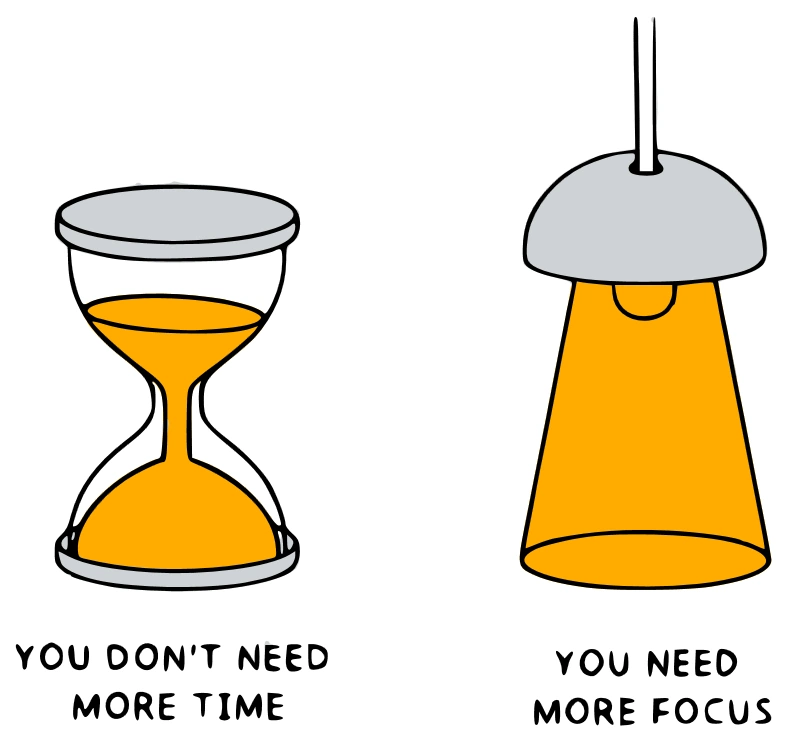Nir’s Note: This guest post is by Jenny Wood, a former Google executive who led one of the company’s biggest career programs, helping thousands take charge of their professional growth. Her new book, Wild Courage: Go After What You Want and Get It, is a bold guide to standing out and getting ahead by embracing 9 unexpected traits.
Most professionals don’t struggle with time management. They struggle with people-pleasing.
From an early age, we’re conditioned to say “yes.” Yes to additional responsibilities. Yes to impromptu meetings. Yes to anything that signals we’re cooperative team players. But this automatic response creates a significant dilemma: every time we say yes to something inessential, we’re implicitly saying no to work that actually matters.
As Nir Eyal points out in Indistractable, if you don’t take control of your time, someone else will.

The Hidden Cost of Interruptions
A study by Gloria Mark from the University of California, Irvine shows that the average knowledge worker is interrupted every 11 minutes. Once that interruption occurs, it takes approximately 23 minutes to fully regain concentration.
This isn’t just frustrating—it’s fundamentally incompatible with meaningful work. A few unexpected notifications, messages, or drop-by conversations can completely derail your productivity and transform your workday into a cycle of distraction and reaction rather than intentional action.
The constant context-switching doesn’t just feel exhausting—it is exhausting. This pattern increases stress, mental fatigue, and error rates, while dramatically reducing your capacity for focused work.
What’s even more concerning is how these interruptions compound over time. If you’re interrupted just five times in a workday (a conservative estimate for most professionals), you’re losing nearly two hours of productive time—not counting the interruptions themselves. Over a week, that’s an entire day of work evaporating into the ether.
The People-Pleasing Trap
Why do we keep falling into this trap? The answer lies in our deeply ingrained fear of social rejection.
During my time at Google, I noticed a pattern among even the most brilliant professionals. Many of us were unconsciously prioritizing short-term social harmony over long-term impact. We’d say yes to a 30-minute coffee chat to avoid potentially hurting someone’s feelings, even if it meant pushing an important deadline into evening hours.
This isn’t just about being nice—it’s about a fundamental misunderstanding of how respect is earned in professional settings. Counter-intuitively, setting clear boundaries often increases others’ respect for you, while constant accommodation can diminish it.
Becoming Intentional With Your Time
Having led major career development programs at Google, I’ve seen firsthand how the highest performers handle their time. They don’t just manage it—they defend it with an almost religious fervor.
I address this challenge in my new book, Wild Courage: Go After What You Want and Get It, where I identify being “brutal” with your time as essential for high performance, a concept that aligns with Eyal’s strategies for becoming “indistractable.”
I used to say yes to everything: meetings I didn’t need to attend, projects that weren’t mine to own, and favors that drained my capacity. While I thought I was being collaborative, I was actually avoiding the discomfort of setting boundaries.
When I finally began protecting my time as if my career depended on it (because it did), I discovered something surprising: no one seemed to mind. My colleagues didn’t keep score of declined meeting invitations or take offense at my newfound boundaries. Instead, I finally had bandwidth for the work that truly mattered.
The Psychology of Saying No
What makes saying “no” so difficult? Neuroscience offers some insights. When we anticipate potential social rejection, our brains activate the same regions associated with physical pain. This helps explain why declining requests feels so uncomfortable—we’re literally wired to avoid it
Understanding this biological response is the first step toward overcoming it. The discomfort you feel when setting boundaries isn’t a signal that you’re doing something wrong—it’s simply an outdated survival mechanism firing in a context where it’s no longer helpful.
The good news is that this discomfort diminishes with practice. Each time you successfully protect your time without damaging relationships, you’re retraining your brain to associate boundary-setting with positive outcomes rather than social danger.
Practical Ways to Protect Your Time
If you want to reclaim your schedule this week, try this five-step approach:
- Audit your calendar: Identify your biggest time-wasters and recurring distractions. Look for patterns—are there specific people, projects, or meeting types that consistently drain your energy without proportional returns?
- Practice saying no—without over-explaining: Keep it simple with “I can’t commit to this right now.” Research suggests that using the word “can’t” rather than “don’t want to” is perceived as less personal and more acceptable to the receiver.
- Time-block your focus work: Schedule and defend periods for focused work as if they were unmissable meetings. Eyal calls this technique “timeboxing” in Indistractable and it’s one of the most powerful tools for ensuring that your priorities actually get your time.
- Create friction for interruptions: Make it slightly harder for others to access your time. This might mean closing your office door, working from a different location, or using status indicators in communication tools to signal when you’re in focused work mode.
- Batch similar activities: Group similar tasks like email checking, Slack responses, or approval reviews into dedicated time blocks rather than allowing them to fragment your entire day.
When you need to decline requests gracefully, these three simple scripts can help:
For meeting requests: “I’d love to help! Can we start by collaborating via email to get ideas flowing? If we need more time after that, I’m happy to explore meeting options.”
For timeline management: “I’m deep into a priority project this week, but I’d be happy to circle back next week. Does that timeline work for you?”
For clarity on commitments: “Happy to discuss this further. Could you send over a quick agenda first, so I can see where I can best contribute?”
These approaches allow you to maintain relationships while protecting your most valuable resource—your attention.
Free Habit Tracker
Design your ideal day and build your best life.
Your email address is safe. I don't do the spam thing. Unsubscribe anytime. Privacy Policy.
Traction, Not Busyness
Being busy doesn’t build success. Being intentional does.
The path to meaningful productivity isn’t about filling every minute of your calendar. It’s about creating the time and space for traction—making progress on what matters most to you. This connects directly to Eyal’s concept of “traction” versus “distraction,” where traction pulls you toward what you want while distraction pulls you away.
I’ve found that the professionals who advance most rapidly aren’t necessarily working more hours—they’re working more focused hours. They’ve mastered the art of saying no to the trivial many so they can say yes to the vital few.
By setting appropriate boundaries around your time and attention, you aren’t being difficult or uncooperative. You’re creating the conditions necessary for your best work to emerge. You’re telling the world that your contribution matters enough to be protected.
What’s one boundary you could set this week to protect your time and attention?
Related Articles
- Schedule Maker: a Google Sheet to Plan Your Week
- Habit Tracker Template in Google Sheets
- The Ultimate Core Values List: Your Guide to Personal Growth
- Timeboxing: Why It Works and How to Get Started in 2025
- An Illustrated Guide to the 4 Types of Liars
- Hyperbolic Discounting: Why You Make Terrible Life Choices
- Happiness Hack: This One Ritual Made Me Much Happier

